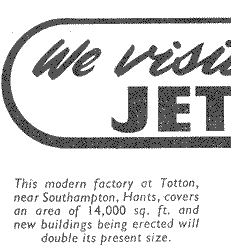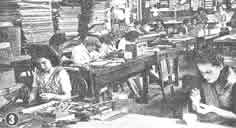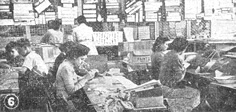 |
 |
 |
 |
 |
|
We Visit Jetex
Reprinted from Model Aircraft, August 1951, pp. 374, 375
|
|
  |
WHAT are the three outstanding achievements in the field of commercial model aircraft since the war? If we were given that question we would settle for : the introduction of the miniature compression-ignition (diesel) motor, the glow-plug, and Jetex. The first was Continental in origin (although this country now leads the world as regards commercial diesels). The glow-plug came from America. Jetex is our own home invention and development. Slow to take on at first, Jetex units are now being used throughout the world. America is very keen on them. Australia introduced a Jetex class for their Nationals, and other countries are following suit.
Managing directors of the firm responsible for producing Jetex are no newcomers to the model aircraft trade. J. N. Mansour and C. M. Wilmot were intimately connected with A. E. Jones when the first model aircraft meetings were held and in the days when balsa wood was still an unknown quantity. Modellers need long memories to appreciate the mention of A. E. Jones. Around 1930 his tiny little shop in New Oxford Street, London, was the "mecca" of model aircraft enthusiasts of that time. Here was the finest selection of modelling materials in the country and when balsa wood did arrive, A. E. Jones was about the first person to sell it. The writer remembers trying some at the time and deciding that it was awfully tricky stuff, for the "cement" used was not capable of sticking it !
|
|
Probably not many people are aware that Messrs. Wilmot and Mansour were the originators of the "Frog" model aeroplanes and associated kits, this in the mid-1930's. Even in those pre-war days Frog models and kits set a standard of excellence in pre-fabrication and design which has remained virtually unrivalled throughout the world to this day.
Daring the war Charles Wilmot was largely responsible for the development of 16 and 32 ft. span winged targets, used by the Navy and other services. Joe Mansour designed and produced free flying glider targets and rocket-propelled glider targets for the Navy and the Army.
|
|

1. Assembling boat frames with automatic gluer
|
-
Model Aircraft, August 1951, p. 375
|
|
It was actually through this latter development that "Jetex" was conceived. Some time before war had
finished, Messrs. Wilmot and Mansour had severed their connections with "Frog" and started on their
own as Wilmot, Mansour and Company Ltd., at Totton, near Southampton. With their post-war future in
view, Imperial Chemical Industries were approached with a view to working on a suitable fuel for small
rocket motors. Two years of development then followed, carrying the experiments into the post-war
period. Then, on October 18th, 1947, the first model aeroplane powered with a 1 oz. thrust prototype
"Jetex" motor took to the air. It certainly flew all right, for it was lost on its first time out !
Rumours had reached the trade meanwhile that a small "jet motor" was being developed for the model aircraft trade, but few people knew what form it would take. Then "Jetex" was first displayed at the British Industries Fair on May 3rd, 1948, and kit production started in the same year with the Mi-Jet and Dura-Jet.
|
|

2. Designing a new Jetex kit
|
-
Model Aircraft, August 1951, p. 375
|
|
As we have said before, the acceptance of "Jetex" was slow at first in this country. There was a
popular misconception that it was expensive—twopence, threepence, or so, a flight. This ignores
the overall cost of flying any other type of power model and on a matter of pure economics,
Jetex works out cheaper than any other form of power in the long run. It has two other advantages.
For the designer, it has no torque. For the ham-handled flier, well you just cannot break up a Jetex
unit in a crash like any other power plant !
Jetex sales figures have now reached a figure of something like £100,000 (retail) value annually.
Export figures account for some 60 per cent of production and it is expected that 1951 will set
new production records. It is estimated that American orders alone will total some £150,000 in
(retail) value ! Also practically every European country of note is now taking Jetex in very large
quantities. Part of this are kits, part Jetex motors themselves. Kit production averages some 3,000
per week.
|
|

3. View
showing part of general assembly shop
|
-
Model Aircraft, August 1951, p. 375
|
|
The future for Jetex holds many interesting possibilities, and development work is constantly being
carried out. The immediate aim is more thrust for less weight, and more efficient fuel consumption.
A Jetex turbine is also being developed for turbo-jet propulsion.
Unfortunately, production of this and other new power plants may be delayed for some considerable time as much of the works capacity is now absorbed on the rearmament programme. The company has another side to its activities besides Jetex models and that is the special packaging and preserving of armament supplies. This side of the business now threatens to swamp model aircraft production, but it is the firm intention of the directors to continue with all Jetex lines.
The range of kits manufactured by Wilmot, Mansour is already quite considerable, and with sufficient variety to appeal to all tastes. Quite the most remarkable design in the range is, of course, the Jeticopter, about which much has already been written. That, and the introduction of the first practical flying scale jet models, is just another example of the ingenuity and resourcefulness of the company.
|
|

4. Milling a plastic
forming die.
5. Pressing plastic parts.
|
-
Model Aircraft, August 1951, p. 375
|
|
Of the new kits coming along, one is a new Jetex 200 contest model designed by Ian Dowsett (who is now in the Forces). Experimental work is proceeding with a twin-jet flying boat and a delta-wing model. In the "experimental" category Jetex motors have been tried with long tail pipes to overcome the loss of thrust experienced if the Jetex motor is fully enclosed in the fuselage or nacelle. Wilmot, Mansour and Company have a modern, well-equipped factory with a present size of 14,000 sq. ft. It is situated in country surroundings with a flying field and testing grounds for jet cars and boats included. To meet the ever-increasing demands for their products, new buildings are going up which will double the factory space available by the end of the year with, no doubt, a considerable addition to their present staff total of approximately one hundred employees.
Mention of jet cars and boats brings to mind the plastic (Jetex) Race Car and Speed Boat, both entirely made in the factory and involving a special technique developed by Wilmot, Mansour and Company over a period of years. Every facility is available for large scale plastic production along the most modern lines and one of the new items in this field is a completely pre-fabricated plastic Jeticopter which it is hoped will be on the market by the end of this year.
With so much scope, experience in the industry, a sound organisation and design and production skill
amounting almost to genius, model aircraft enthusiasts can look forward to a treat with every new
Jetex product announced. We know, we were among the people who did not take too kindly to Jetex
flying at first. Having had some experience with it we now rate it tops—for real flying fun.
|
|

6. Kit packing department
|
-
Model Aircraft, August 1951, p. 375
|
|
 |
 |